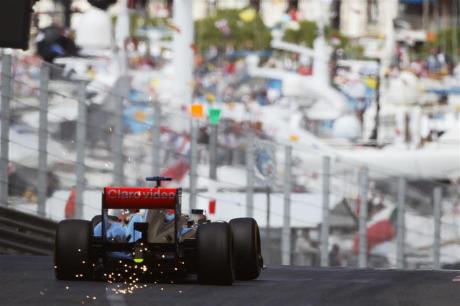Amongst the decisions of the FIA WMSC last week was the move to mandate titanium skid plates on Formula 1 cars for 2015.
These plates were tested at the Austrian Grand Prix with some success, although as seems to be the all too frequent case in modern day Formula 1, little to no official warning or explanation was given as to the test taking place, and even less so as to its intentions.
It was thus presumed that the sole reason for titanium skid plates was to bring back sparks and to manufacture something twinkly and exciting, to elicit the golden era of Formula 1. While there is some truth to this, the real reason is perhaps far more intriguing.
Earlier this week at Silverstone, Charlie Whiting took questions from the press on a variety of topics, and his explanation of the substance and intention of the skid block regulation, when quizzed upon it by the BBC’s Andrew Benson, was fascinating.
“To explain: the plank is the long bit of wood, the skids are bits of metal within the plank. The skids have formerly been made of a heavy metal, which has been very resistant to wear, and they put the skids around the points in the plank where thickness is measured. Planks have to start off at nominally 10mm thick and they can’t be less than 9mm thick. However, we only measure them around certain holes in the plank. So they position the skids around those holes.
This metal is extremely heavy and when pieces detach they can be extremely harmful. We saw two punctures in Spa previously because of bits of this metal that lay in a kerb and caused damage. In a worst case scenario they could fly off and hit someone.
The purpose of making them out of titanium is threefold: Firstly, it’s safer, because if they do come off they are about a third of the weight of the existing ones. Secondly, the titanium wears some 2-2.5 times more quickly than the metal currently used. Thus cars will have to be run a little bit higher to manage wear and teams won’t be able to drag them on the ground quite as much as they have in the past. The third effect is that you will see a lot more sparks, which some people think will look a little more spectacular.”
It is the second of the three purposes which, I understand, was the greatest force behind this change for next season. Sources have suggested to me that only one team opposed the change to titanium skid plates next season… and it was for precisely the reason that Charlie outlined.
Fears had started to appear that at least one team was running their car excessively low to the ground, but that this practice was going either unnoticed or unpunished because the skid plate is so strong as to protect the car.
By mandating titanium and thus reducing the strength by 2 to 2.5 times, as Charlie outlined, this practice will be eliminated.
Had the FIA simply made this clear from the outset, the hullabaloo over the return of titanium skid plates as what we understood to be a purely cosmetic fix, would not have existed.
All we ask is information. This dripping tap culture of information dissemination from the governing body just casts everyone in a bad light.





Thanks for that info Will!
Great info, it’s unfortunately that this was not disclosed..,Which is the team running low? Red Bull ?
I’m surprised you have to ask.
Interesting stuff. Near the end you said titanium would reduce strength 2-2.5 times. I think you mean increase wear 2-2.5 times. I’m sure you know wear resistance and strength are not the same thing!
I don’t really follow, just because the regulations specify that you have to run titanium blocks in a particular place, of a particular size, could you not just stick your old block right next to it and pretty much negate it altogether?? Whenever the car bottoms out it would hit your block, not the Ti one and you are back to where you were?
I could count the sparks! No, better leave it then….
Thanks man 🙂